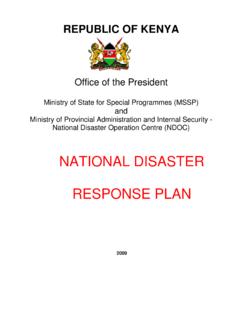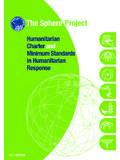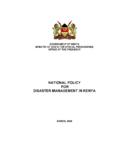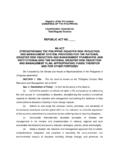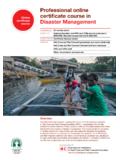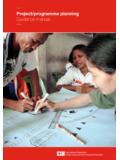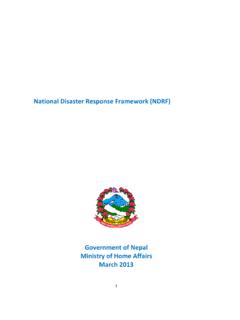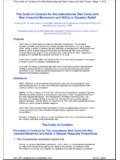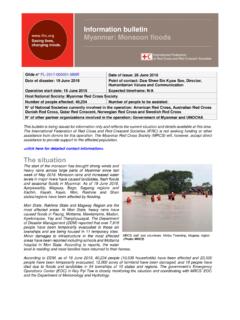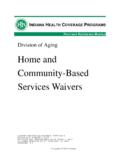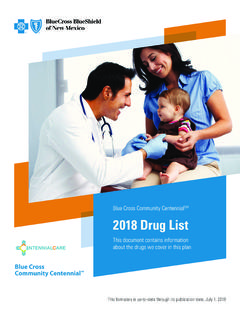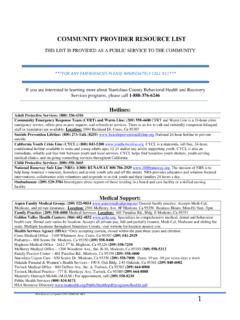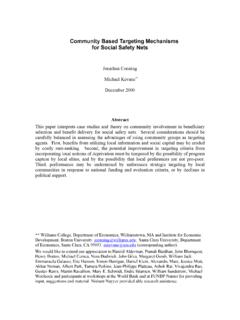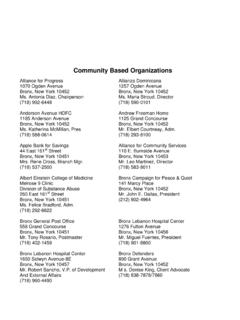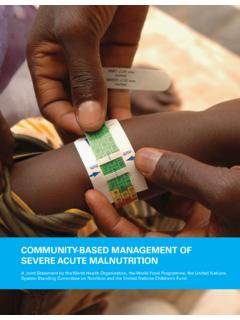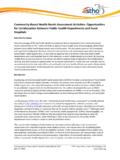Transcription of Characteristics of a Safe and Resilient Community ...
1 Characteristics of a safe and Resilient Community Community based Disaster Risk Reduction Study ARUP International Development September 2011. Saving lives, changing minds. International Federation of Red Cross and Red Crescent Societies, Geneva, 2012. Copies of all or part of this study may be made for noncommercial use, providing the source is acknowledged The IFRC would appreciate re- ceiving details of its use. Requests for commercial reproduction should Box 372. be directed to the IFRC at CH-1211 Geneva 19. Switzerland The opinions and recommendations expressed in this study do not nec- Telephone: +41 22 730 4222. essarily represent the official policy of the IFRC or of individual National Telefax: +41 22 733 0395. Red Cross or Red Crescent Societies. The designations and maps used E-mail: do not imply the expression of any opinion on the part of the Internation- Web site: al Federation or National Societies concerning the legal status of a terri- tory or of its authorities.
2 All photos used in this study are copyright of the Characteristics of a safe and Resilient Community IFRC unless otherwise indicated. Cover photo: Japanese Red Cross. 1224200 E 05/2012. Community based Disaster Risk Reduction Study Characteristics of a safe and Resilient Community Contents Page Acknowledgments i Executive Summary ii 1 Introduction 2. 2 Research Methodology 4. Literature Review 5. Fieldwork 6. 3 Findings: Literature Review 10. Overview 10. Factors contributing to safe and Resilient communities 12. A long list' of Characteristics 14. 4 Findings: Fieldwork 17. External Resources and Relationships 17. Shocks and Stresses 20. Factors contributing to safe and Resilient communities 23. Reliance on others 28. Changes to factors contributing to safe and Resilient communities 28. 5 Analysis 38. What are the Characteristics of a safe and Resilient Community ? 38. What is the impact of CBDRR programmes?
3 49. 6 Conclusion and Recommendations 58. Characteristics of a safe and Resilient Community 58. Impact of CBDRR programmes 58. Recommendations 59. 7 References 61. Community based Disaster Risk Reduction Study Characteristics of a safe and Resilient Community Tables Table 1: Key documents included in literature review .. 5. Table 2: CBDRR programmes in Sri Lanka, Indonesia, Thailand and the Maldives.. 6. Table 3: Communities included in the fieldwork .. 7. Table 4: Summary of fieldwork findings: How have the factors that make your Community safe and Resilient changed over time? .. 30. Table 5: Literature review and fieldwork factors associated with human assets.. 39. Table 6: Literature review and fieldwork factors associated with social assets.. 41. Table 7: Literature review and fieldwork factors associated with access to external resources.. 43. Table 8: Literature review and fieldwork factors relating to physical assets.
4 45. Table 9: Literature review and fieldwork factors relating to access to economic assets .. 47. Table 10: Literature review and fieldwork factors relating to environmental assets .. 48. Figures Figure 1 Diagrammatic representation of interrelationship between outputs .. iii Figure 2 The six Characteristics of a safe and Resilient Community .. iv Figure 3: Simplified representation of research methodology .. 4. Figure 4 Concepts arising from literature review .. 11. Figure 5 CBDRR programmes contribute to a safe and Resilient Community .. 12. Figure 6 Conceptual framework for Community Resilience.. 13. Figure 7: Diversity of Communities .. 17. Figure 8 Government Structures from a national to sub- Community level.. 18. Figure 9 Community group tasked with disaster management.. 19. Figure 10 Top 3 shocks and stresses identified across the four countries (13. communities in Indonesia, 9 in Sri Lanka, 4 in the Maldives and Thailand).
5 21. Figure 11 Distillation and grouping of factors .. 23. Figure 12 Example of Exercise 2: What makes your Community safe and Resilient ?' .. 24. Figure 13 Responsibility for factors contributing to Community safety and resilience.. 28. Figure 14 Number of factors identified in the communities for each characteristic .. 51. Figure 15: Graphic representation of change in strength.. 51. Figure 16: Graphic representation of change in strength.. 52. Figure 17: Graphic representation of change in strength.. 53. Figure 18: Graphic representation of change in strength.. 54. Figure 19: Graphic representation of change in strength.. 55. Figure 20: Graphic representation of change in strength.. 56. Figure 21 The six Characteristics of a safe and Resilient Community .. 60. Appendices Community based Disaster Risk Reduction Study Characteristics of a safe and Resilient Community Appendix A.
6 Process Documentation Appendix B. Supporting Documentation International Federation of the Red Cross and Red Crescent Societies Community based Disaster Risk Reduction Study Characteristics of a safe and Resilient Community Acknowledgments The study team would like to thank the IFRC for giving Arup's International Development team the opportunity to complete this study. Our special thanks go to Mohammed Mukhier (IFRC CPRR), Chris Staines (IFRC Tsunami Unit) and Susil Perera (IFRC Asia Pacific Zone) for their technical and procedural support throughout. We would also like to thank the members of the working group who guided the implementation of this study, and provided invaluable comments and feedback on the draft reports; Rod Snider (American Red Cross), Gail Neudorf (Canadian Red Cross), Robert Roots (British Red Cross), Bhupinder Tomar (IFRC Vietnam), Michael Annear (IFRC Asia Pacific Zone), Kaspar Bro Larsen (Danish Red Cross) and Thorsten Klose (German Red Cross).
7 Particular thanks go to the National Societies and IFRC delegates who supported our study team during the fieldwork; the Sri Lankan Red Cross Society, the Maldivian Red Crescent Society, the Thai Red Cross Society and Palang Merah Indonesia (PMI). Without their support the primary research would not have been possible and their commitment during the fieldwork made a significant contribution to the final outcomes of the study. Finally we would like to thank all participants at the output review workshop held in Geneva from 20-21 July 2011whose feedback and comments have been valuable in finalising this report. Arup International Development's study team;. Jo da Silva, Victoria Maynard, Elizabeth Parker, John Twigg, Rumana Kabir, Geoffrey Chan, Flora Tonking, Andy Kervel. 29 September 2011. Page i International Federation of the Red Cross and Red Crescent Societies Community based Disaster Risk Reduction Study Characteristics of a safe and Resilient Community Executive Summary The International Federation of the Red Cross (IFRC), as the world's largest humanitarian and development network' is committed to building safety and resilience through its Community based Disaster Risk Reduction (CBDRR).
8 Programmes1. As a movement the Red Cross-Red Crescent (RCRC) has significant knowledge and experience of implementing CBDRR programmes. However, defining the aims and objectives of such programmes and the critical factors that influence their impact remains a challenge. This is particularly acute when comparing outcomes and approaches between communities, countries and regions. CBDRR programmes were carried out in over 700 communities as part of the Tsunami Recovery Programme (TRP) alone. The IFRC have identified this as an opportunity to identify and document lessons learned in implementing at scale CBDRR2 projects to strengthen Community safety and resilience .also [to] use its large evidence base to research new ideas and contribute to the wider efforts in improving CBDRR work within the IFRC' (IFRC, 2010: 2). This research report on the Characteristics of a safe and Resilient Community has been prepared by Arup's International Development team (Arup ID)3 on behalf of the IFRC as part of a wider CBDRR Study of the TRP.
9 Specifically, this report draws on the experience of the TRP CBDRR programmes and current literature in order to identify the Characteristics of safe and Resilient communities; to understand how these Characteristics changed over time and how RCRC interventions have contributed to this change' (IFRC, 2010: 3). It is intended that the Characteristics arising from this research will be used in the design, monitoring and evaluation of future programmes. A first step towards this is the lessons learned report which provides a further output from this study. Other outputs of the study include a who, what, where database of RCRC. CBDRR projects; and a research report identifying the key determinants of a successful CBDRR project. Box 1: Additional research questions identified in the concept note (IFRC, 2010). What do communities perceive as the most important Characteristics needed to be safe and Resilient ?
10 '. Is there a set of such Characteristics that are common across all communities despite being located in different countries and settings?'. How do communities rank their changes in Characteristics , and how have RCRC. interventions contributed to these changes?'. How do the changes over time reflect shifts in Community attitudes and behaviours towards risk?'. 1. IFRC, 2. The acronym CBDRR is used to include CBDP, CBHFA, CCA, ICBRR, etc. 3. Arup International Development (Arup ID) operates as a not for profit group within the Arup Group Ltd (Arup). 29 September 2011. Page ii International Federation of the Red Cross and Red Crescent Societies Community based Disaster Risk Reduction Study Characteristics of a safe and Resilient Community Figure 1 Diagrammatic representation of interrelationship between outputs Methodology This research into the Characteristics of a safe and Resilient Community is based on both secondary and primary data sources.
